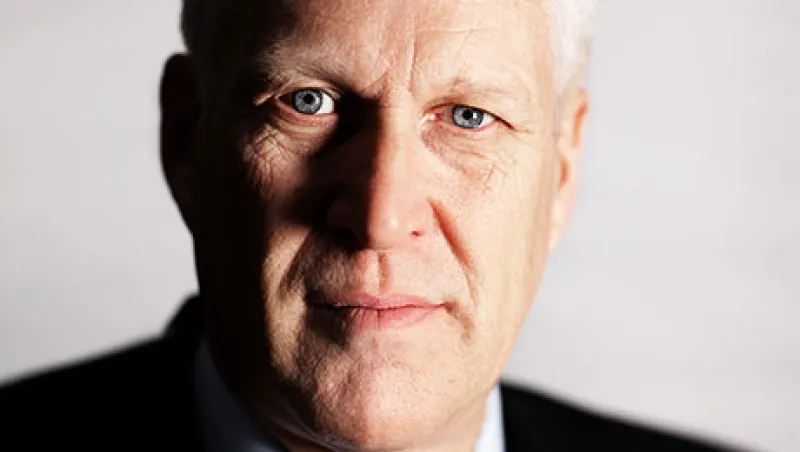When Louis Chênevert took over as chief executive of United Technologies Corp. from legendary CEO George David six years ago, many analysts questioned whether the former auto industry production manager could fill such big shoes. David was a larger-than-life figure who grew UTC’s market capitalization more than ten times during his 16-year tenure at the helm.
Today no one doubts that UTC is Chênevert’s company. The tall, fast-talking French-Canadian, 56, has remolded United Technologies by bulking up its aerospace business and consolidating its building systems activities. He wants the company to prosper from continued urbanization in emerging markets and ever-growing demand for air travel. “The Chinese government has said that by 2030, 60 percent of its population will take at least one trip a year on an airplane,” he says. “So am I excited about aerospace? Yeah.”
In 2012 the company paid $18.4 billion to acquire Goodrich Corp., the world’s largest maker of aircraft landing gear. Combined with UTC’s Pratt & Whitney and Hamilton Sundstrand units, the deal gives Chênevert one of the industry’s broadest portfolios of aircraft equipment at a time when airlines are placing record orders.
On the ground, as it were, Chênevert has looked to drive synergies through reorganization rather than acquisition. Over the past three years, he has combined a variety of brands — including Carrier air-conditioning, Otis elevators, Kidde fire alarms and Chubb security systems — in a single division, Building & Industrial Systems. The division was expected to generate $29 billion in sales last year, or 46 percent of the group’s $63 billion in sales.
An operational focus comes naturally to Chênevert, who has a bachelor’s degree in production management from the University of Montreal’s business school. He spent 14 years at General Motors Corp., rising to production manager at its Ste. Thérèse, Quebec, plant, before joining Pratt & Whitney in 1993. He rose swiftly to become president of the aircraft engine division in 1999 and group president and COO in 2006. As his predecessor David once said, “I can go into a factory and in 15 minutes tell you whether things are working right. It takes Louis 15 seconds.”
Chênevert has sharpened the group’s profitability as well as its product lineup. He paid for Goodrich in part through more than $4 billion of disposals, including Rocketdyne space propulsion, Hamilton’s pumps and compressors business, and subsidiaries making fuel cells and windmills. Overall, the group was expected to generate 15 percent growth in earnings per share last year on flat sales; Chênevert predicts a further rise in EPS of 7 to 11 percent this year.
The big question mark is defense. Uncle Sam is the company’s biggest customer, generating 17 percent of sales. U.S. budget sequestration and the pullback of forces from Afghanistan hit revenues last year. Chênevert forecasts a further 3 to 5 percent drop in government revenues this year, but he believes the company’s big projects should be relatively immune to cutbacks: Pratt is the sole engine supplier for the F-35 Joint Strike Fighter (JSF), and UTC’s Sikorsky unit is developing a new heavy lift helicopter for the Marine Corps.
Chênevert spoke recently with Institutional Investor International Editor Tom Buerkle.
Institutional Investor: Corporate America has seen very little top-line growth. Do you foresee any change in that environment?
Chênevert: We expected ’13 to be a year of organic growth resuming. It turned out it wasn’t there in the first half, but in the back half we started to see orders accelerate. We delivered 1 percent organic growth in Q3, and we’ll deliver more in Q4. The backlog is now there to sustain that momentum in the first half of 2014.
The Goodrich deal raised a lot of eyebrows because of its size. Now that you’ve integrated the business, do you feel justified?
I feel very good about it. Goodrich is truly transformational. Its aerospace components are complementary to the rest of our portfolio. The cultures have meshed well. It’s made a real good contribution to the bottom line of the company. We’ve been able to win now at Embraer, especially with the E2, more content than we had on the prior platform because we can combine the Pratt geared turbo fan (GTF) engine with [Goodrich’s] nacelle and brake system and [Hamilton Sundstrand’s] electric system.
Pratt for a couple of decades was seen as an aero company that was mostly small engines and military. We’ve totally reversed our position with the Bombardier CSeries and Embraer too. With the Airbus A320neo, we’ve got more than 50 percent of the engine orders so far. GTF is a remarkable value creator. Not only does it produce 16 percent better fuel burn, but the noise footprint is reduced by more than 70 percent, which means airlines can eliminate curfews and noise abatement routes. At New York’s LaGuardia Airport, that can mean a 5 percent shorter en route time.
GTF orders are ramping up, but you’re incurring losses because profits come later in the product cycle. Is that a problem for you?
It’s a headwind, but Pratt will be extremely well positioned long term. And there are other elements to Pratt. You’ve got the helicopter engine; you’ve got the regional engine; you’ve got the fighter engine. In 2015, as the CSeries enters service and then the A320neo, the JSF will ramp up. It’s the best fighter in the world, bought by eight nations. JSF is going to go from about 50 a year at this point to 200 a year by the end of 2015. And on the aero commercial side, we’re going to more than double the volume. Pratt will go back to 1980s-style volume.
The sequester hit Pentagon spending in 2013. How do you deal with the uncertainty?
Well, No. 1, the Department of Defense is our largest customer. We have had and we continue to have fantastic programs, relationships. The good news for UTC is that we are on the key projects for the future. We’ve got the JSF. That’s 30 years of future. The ramp-up is a little slower than we expected, but with the international demand it’s starting to look pretty good. We have the KC-46 tanker competition that we won with Boeing, where we supply the PW4000 engine. That’s also 20, 30 years of future. Look at Sikorsky. The Black Hawk has been the workhorse, and it’s going to continue to be the workhorse for the next decade. We signed a partnership with Boeing to do a joint multirole, a bit like the JSF, to make a single replacement for Apache and Black Hawk helicopters, and that is going very well. And we’ve got the only new helicopter development program right now, which is the CH-53K for the Marine Corps.
You keep reorganizing your building systems businesses. Why?
Two years ago I combined Carrier and UTC Fire & Security. They had different contact points at the customer, yet they were selling to the same building owner in many cases. So I thought there’d be simplification and good value creation by having the field service and the sales office combined under one roof. I gave Geraud [Darnis, CEO of UTC Building & Industrial Systems] a 15 percent return on sales target, which people thought was probably unachievable. Carrier’s always been a high-single-digit-return business. And yet we finished 2013, and we’re up to a 15.5 percent return on sales.
A reorganization can look good on paper. How do you make sure it works in reality?
The key is we’re combining field offices. We had 2,500 field officers that were not under a single roof. Otis had an office in town, and then Carrier had its own, and Kidde and Chubb had their own. We put all these people under a single roof. Even if you don’t make the change yet of how they serve the customer, guess what happens? Someone says,“Hey, by the way, I’m going to see customer X because there’s a project with this architect.” “Oh, I didn’t know there was a project. What kind of building? What structure?” Through a Carrier relationship with [Indian engineering and construction company] Larsen & Toubro, which has been a prime customer of Carrier for probably two decades, Otis won a contract for 670 units of elevators and escalators for the Hyderabad metro. And Larsen was not an Otis customer. That’s why I’m so optimistic.
In the past year growth has come off in emerging markets. Is this just a bump in the road or a more significant issue?
I’m very optimistic about emerging markets. China’s still the bright spot of Asia. It’s having 7-ish percent GDP growth, which I think is more sustainable. The big shift is in where the action is. For a long time the coastal area was booming, with places like Shanghai and Guangzhou growing in double digits. Now the coastal area is almost flat to maybe 2 percent GDP growth. The action is now central and west — places like Chengdu, like Chongqing.
How are you adjusting your operations?
Well, we invested in a new factory just two years ago in Chongqing to produce elevators. This year the factory’s going to produce 8,000 or 9,000, and next year they will be at capacity, around 15,000 to 16,000. We have another factory in Chengdu that’s at capacity. The good news is the strategic move of investing in a new factory is paying off. And that market looks like it wants to boom for the next decade.
Can you see India rivaling China in terms of business for UTC?
India’s been a lot more challenging. Last year India had $1 billion in sales for UTC; China was $4 billion. When I took over at UTC, India was about $150 million, $200 million. So it’s moved a lot. Will it catch up with China? I don’t think so.
Are you developing more products in emerging markets?
If you take our commercial companies, 90-plus percent of what we sell in China is made in China. It’s important to understand that we now are designing products globally. There was a time when most of the R&D was done just in America and Europe.
A new air-conditioning model, the Evergreen Chiller, was developed in Shanghai. The same design is now manufactured globally. There’s a lot of power fluctuation in India, so we’ve designed this battery powered elevator that’s plugged into the 110 volt [electricity supply] so that if there’s power surge or outage, you can do almost a hundred cycles without power. This is a favorite in India. And guess what? It’s a lot more reliable because the battery/inverter system eliminates the power fluctuations that destroy the electronics. Now that design has gone to Europe as well because for some small buildings it’s just a very effective technology. You don’t have to upgrade the power system when you replace an old elevator with different voltage.
Are you going to be doing more of this?
This is a new dynamic going forward. Sixty percent of my sales are outside the U.S. These markets demand the most-advanced products. So we’ve got to understand some of those needs and craft these products for the unique needs.
What’s your outlook for the U.S.?
We had a good year in 2013, and the new forecast suggests next year’s going to continue to improve, driven by household formation. I think the inventory of excess homes has been taken care of, and now you’re starting to see the builders. And that’s an important factor for the U.S. economy, for job creation and also for our business because of all the stuff we do. We think commercial real estate’s going to start to recover, and that’s based on the project interaction we’re having with our customers. And then on the aerospace side, the U.S. airlines have some of the older fleets, and there’s a big appetite to renew those fleets. So I think that’s going to cause us to see nice demand by some of these U.S. airlines.
Everyone complains about weak job growth; companies are sitting on cash. What is going to jump-start the economy?
Despite the uncertainty created with the debt ceiling drama, the economy has been on the mend, which is a pretty strong sign. I’m encouraged by this recent [budget] deal that has been announced with [U.S. Senator] Patty Murray and [U.S. Representative] Paul Ryan. Having a budget deal for two years brings a lot of certainty, and while it might not be the optimal deal, it beats the alternative of creating more uncertainty. There’s a window for tax reform. If you have a tax reform where the rate that’s proposed is more competitive with OECD countries, guess what? This cash that’s sitting on the side will be put to work.
You’re sitting on about $5 billion in cash, most of it overseas. Would you do anything with that if Congress passed a tax holiday on repatriated earnings?
Well, first of all, a lot of that cash is used for operations offshore. Sixty percent of revenue comes from outside the U.S., so it’s normal a lot of cash comes from outside.
I don’t believe in a tax holiday. A tax holiday gives you a one-timer, but you don’t have long-term certainty. And that’s why I decided it was time for me to chair the BRT tax committee. We need to become competitive with OECD countries in a global tax system. We’re dead last. For a long time Japan had the highest rate. Now it’s the U.S.
Going back ten years, we’ve paid anywhere from 28 to 30-ish, 31 percent on a marginal tax rate that is 35 percent. We like the idea of a 25 percent tax rate or even 28 percent. I’ve got hundreds of people in our company working the complexity of the tax system, and I think that’s true across corporate America. Having a simpler system would be a great friend to businesses.






